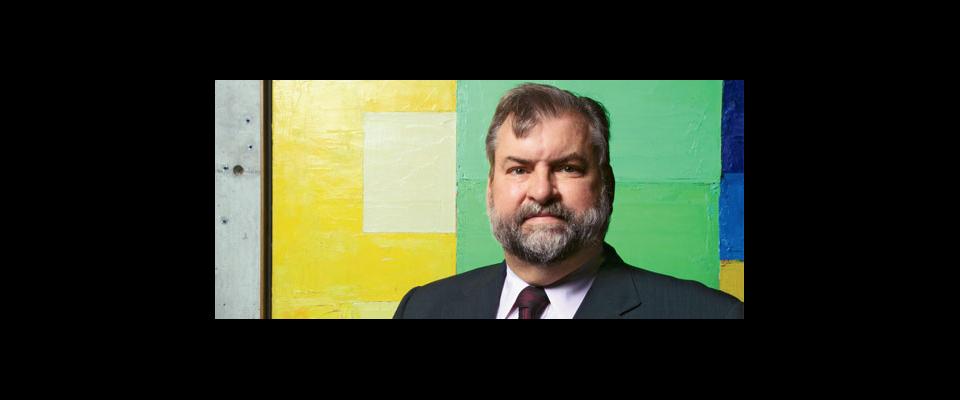With the addition of the Fisher Collection, SF MOMA becomes a world destination.
Gary Garrels, senior curator of painting and sculpture at the San Francisco Museum of Modern Art, was nursing an afternoon espresso in the museum’s rooftop atrium and looking very content. A large, delicate swarm of spiders, Louise Bourgeois’s The Nest, loomed nearby. Between sips, Garrels explained how the spindly bronze arachnids came to be there.
It began in 1997, when Donald Fisher ’50, the SFMOMA trustee and assiduous collector of mid- to late-20th century art (and Cal Alumni Association 2007 Alumnus of the Year), visited a Bourgeois show in Paris with his wife and collecting partner, Doris. “Don called to say he was buying one of the spider sculptures,” Garrels recalled, “and wondered if the museum wanted one, too.” The museum did indeed want one. And so, with the financial assistance of the Fishers, two Bourgeois sculptures found a new home in San Francisco. The Fishers’ spider joined their matchless assemblage of modern art seen almost exclusively in the private corporate headquarters of Gap Inc., cofounded by the Fishers in 1969.
The Bourgeois moment was by no means the only instance of what SFMOMA director Neal Benezra called the “parallel” collecting of Fisher and the museum. Works by Ellsworthy Kelly, Richard Serra, Cy Twombly, and other prime artists of the era were acquired in mutually reinforcing ways–including some 37 jointly owned works. Last fall, those parallel lines converged.
In an announcement that had seemed by turns preordained and then doomed never to come, the Fishers agreed to house their rich, deep, and balanced collection of more than 1,100 works at a greatly expanded SFMOMA. With that single act, SFMOMA joined the ranks of New York’s MOMA, London’s Tate Modern, and Paris’s Centre Pompidou as essential destinations for anyone who cares about the art of the past century. Two days after the announcement, at age 81, his last great project complete, Don Fisher died at home of cancer.
For years before that horizon-changing September event, the fate of the Fisher collection in the Bay Area was very much in doubt. Thwarted in his attempts to build a dedicated museum in San Francisco’s Presidio and apparently wounded by some of the vituperative criticism he received for trying, the collector looked far afield. One persistent rumor had Fisher’s artworks bound for the National Gallery in Washington, D.C. Los Angeles and New York were other possible destinations. “Virtually any museum in the world interested in postwar art,” as Garrels put it, “would have been thrilled to get the collection.” No knowledgeable critic would disagree.
But Fisher was a San Francisco loyalist. He served on numerous boards, had helped keep the Giants baseball team in San Francisco in 1992, and contributed munificently to a wide range of local causes. Fisher had his heart set on keeping his Chuck Close self-portraits, Agnes Martin abstractions, and Warhol Triple Elvis close to home. According to the official version of events, Fisher first talked explicitly to SFMOMA about donating his collection in 2006 (although anticipatory exchanges, however glancing, had surely been underway for years). The formal discussions in ’06 apparently broke down over how much of the collection could and would be shown, how it might be integrated with the museum’s own collection, and how it would be curated and programmed.
Director Benezra believes the initial impasse was, in retrospect, unsurprising. “It’s typical for large collectors to work with smaller museums, and for larger museums to acquire smaller collections,” he said. “When it’s a major museum and a collection of this consequence, things become more complicated.”
When the museum talks stalled—by various accounts, amiably—Fisher publicly turned his attention to the Presidio, the verdant and historic former military base on the city’s northern tip. His proposal for a 100,000-square-foot museum, a serene but blockily imposing modernist structure situated at the top of the Main Post parade grounds, was unveiled in 2007. The dramatic design and its pride-of-place location, near the Officer’s Club and the remains of a 1776 Spanish military encampment, polarized opinion.
Some members of the Presidio Trust, the government entity charged with managing the 1,490-acre property, saw a shining opportunity to boldly reshape and reinforce the Presidio’s identity. A museum of great post–World War II art, as the Trust’s public affairs director Tia Lombardi reflected recently, could have built “a powerful bridge of understanding from where we were when this was an active military installation to what the U.S. made of itself as a world power. It connected our past to our present and future.” Opponents cited everything from the inappropriateness of a modern art museum, to the size and style of architect Richard Gluckman’s design, to potential traffic woes. It didn’t help matters that Fisher was a wealthy Republican in a city of liberal politics. Comments at the public meetings were often caustic. “It was shocking how personal it became,” said Lombardi.
But even its most prominent critics say Fisher’s project could have worked if the collector had been willing to compromise on the site. “We had no problem whatsoever with a modern art museum near the waterfront down by Crissy Field,” said Gary Widman, president of the Presidio Historical Association. “It could have been like the Sydney Opera House, a landmark and magnet that people would have seen for miles around. A project of this size and nature was never compatible with the parade ground site.”
Fisher did eventually withdraw the Gluckman design and offer a modified and less burly design by another firm. But he remained unbending on the site. Suggestions that he consider other places—including Pier 70 or the troubled Metreon movie-and-retail complex downtown—gained no traction.
Ann Meyer, a former Presidio Trust board member who initially favored the project and later opposed it, offers a revealing piece of this fraught art-politics-personality puzzle. Contrary to the timeline that has Fisher turning his attention to the Presidio in 2006, she said the collector had drawings of a potential Presidio museum as early as 2004. “This did not spring from nowhere in August of 2007,” she said.
As a founding board member of the Presidio Trust (he served until 2005), Fisher apparently had a deep sense of personal investment, even a feeling of destiny about bestowing the great gift of his collection on a gorgeous, historic place that he cared so much about. “I told Don when I saw the Gluckman design that it would never be built, that it was too big,” said Meyer. “But he wouldn’t budge. People who knew him well over the years knew him as an intensely competitive man who was very used to getting his own way and was often described as his own worst enemy.”
Fisher’s intractability about the Presidio site may have delivered the result that was destined all along. “Once the Presidio location fell out,” said Bob Fisher, one of Don and Doris’s three sons, “SFMOMA was the natural solution because it offered the possibility to build a world-class institution, which is ultimately what appealed most to my parents.”
Five or six years from now, assuming SFMOMA can raise the money and solve the architectural challenge of expanding in a compact space adjacent to its current building, the power and eloquence of two great collections will be joined.



















